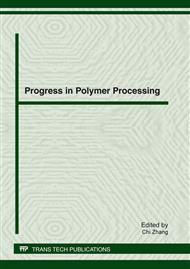[1]
www. petragroup. net, date of accessed 15-03-(2008).
Google Scholar
[2]
W.P. Chamberlin and P.K. Gupta, Use of Scrap Automobile Tire Rubber in Highway Construction, Report 85, Engineering Research and Development Bureau (1986).
Google Scholar
[3]
A.I. Isayev, Encyclopedia of Materials: Science and Technology, Elsevier Science Ltd, Oxford (2003).
Google Scholar
[4]
M. Panda and M. Mazumdar, Engineering Properties of EVA-Modified Bitumen Binder for Paving Mixes, J. Mater Civil Eng. Vol. 11 (1999).
DOI: 10.1061/(asce)0899-1561(1999)11:2(131)
Google Scholar
[5]
T. Gray, Tire Derived Fuel: Environmental Characteristics and Performance, in Conference The Southeast Regional Scrap Tire Management, Nashville, Tennessee (1997).
Google Scholar
[6]
M.A. Mull, K. Stuart and A. Yehia, Fracture Resistance Characterization of Chemically Modified Crumb Rubber Asphalt Pavement, J Mater Sci Vol. 37 (2002).
Google Scholar
[7]
E. Charania, J. Cano and R. Schnormeier, TRB 70th Annual Meeting, Paper No. 910226 (1991).
Google Scholar
[8]
K.E. Giles and W.E. Clark, Asphalt-Rubber Interlayers on Rigid Pavements in New York State, National Seminar on Asphalt Rubber, San Antonio, Texas (1981).
Google Scholar
[9]
B. Burns, Rubber-modified asphalt paving binder, European Patent No. EP0994161 (2005).
Google Scholar
[10]
X.G. Zhong, X. Zeng and J.G. Rose, Shear Modulus and Damping Ratio of Rubber-modified Asphalt Mixes and Unsaturated Subgrade Soils, J Mater Civil. Engg. Vol. 14 (2002).
DOI: 10.1061/(asce)0899-1561(2002)14:6(496)
Google Scholar
[11]
J.C. Wang , X. Zheng and R.L. Mullen, Three-Dimensional Finite Element Simulations of Ground Vibration Generated by High-Speed Trains and Engineering Countermeasures, Journal of Vibration and Control Vol. 11 (2005).
DOI: 10.1177/1077546305056460
Google Scholar
[12]
R.B. McGennis, TRB 74th Annual Meeting, Paper no. 950368 (1995).
Google Scholar
[13]
H. Bahia, TRB 74th Annual Meeting, Paper no. 950792 (1995).
Google Scholar
[14]
S.N. Amirkhanian, ASTM STP 1193, Philadelphia, PA (1993).
Google Scholar
[15]
A.W. Opsahl, L.D. Watson and D.E. Newark, US Patent, 4851463 (1989).
Google Scholar
[16]
J.R. Harrell and L.C. Muschiatti, U S Patent, 4839412 (1989).
Google Scholar
[17]
C.C. Slusher et al, US Patent, 5516817 (1996).
Google Scholar
[18]
R.J. Jolitz and D.R. Kirk, US Patent 4804696 (1989).
Google Scholar
[19]
R.J. Jolitz and D.R. Kirk, US Patent 5026747 (1991).
Google Scholar
[20]
Z. Harold, P. David, L. Robert and B. Mario, US Patent 5100715 (1992).
Google Scholar
[21]
R.J. Jolitz et al, US Patent 5102463 (1992).
Google Scholar
[22]
L.L. Grube, US Patent 5110674 (1992).
Google Scholar
[23]
R.B. Walters, US Patent, 4659381 (1987).
Google Scholar


